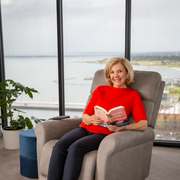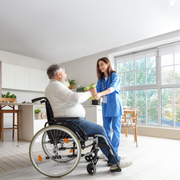- Home
- /
- Buying Guides
- /
- Buyer's Guide To Independent Living

Buyer's Guide To Independent Living
02 May 2025
Practical advice to living at home as you get older
Most older Australians prefer to live at home for as long as possible. And while there are numerous benefits that come with maintaining your independence, this needs to be balanced against the limitations that come naturally with the ageing process.
For people who do choose to remain at home, there are changes you can make and support services available to stay living at home for as long as possible.
Benefits of living at home as you get older
A significant proportion of Australians aged over 65 live at home, with just 1 in 20 living in aged care accommodation. One-quarter of older people are living at home alone.
Beyond a personal preference, there are numerous benefits to older people living at home for as long as possible.
Maintaining independence
Setting your own schedule, having friends and family visit, choosing what to eat and how to spend your time can give people a sense of purpose and self-worth. Being surrounded by your personal belongings and all the memories they hold create a sense of belonging.
This independence can also help older people stay active and mentally alert, which can slow the decline that naturally comes with ageing.
Retaining ties to the community
Living in any place for a while, you begin to develop a routine around the local community. This can mean stopping in at the same cafes and shops, seeing familiar faces on your walk and having regular activities each week.
Staying close to friends and family
Perhaps one of the greatest things about living at home as you get older is that family and friends are able to visit regularly – particularly if they live in close proximity. Neighbours can pop round or chat over the fence and there are people around to check in on you.
Reducing the risk of illness
There are certainly health benefits to living at home, where you are likely to be less exposed to illness and disease. While aged care facilities have strict health standards to protect their residents, living with so many other people, and with visitors coming and going, isn’t without its risks. Living at home means you can control who comes round to visit you and limits your exposure to potential illness.
Looking after yourself
As you get older, it may become harder to look after yourself on your own. Tasks like preparing meals, getting dressed and showering can become more difficult. If you’re finding yourself unable to do these as easily as you’d like, it could be time to change how things are done.
An occupational therapist can help you identify ways to modify day-to-day tasks, including by using aids and equipment. Using your energy and time efficiently can help you get more out of your day, without feeling tired or overwhelmed.
- Getting dressed and undressed is easier with the use of dressing aids, which can minimise the need to bend over to put socks and shoes on, fiddle with buttons, or tie shoelaces.
- A reacher makes it easier to pick up small items and reduces the need to bend or lean over to grab things.
- Using a shower chair or stool with a handheld shower hose not only helps you save energy while bathing but can also reduce the risk of slipping. You can even sit on the chair to dry off and get dressed.
- Modified kitchen equipment makes it easier to prepare food. Automatic can openers, silicone jar openers, tap mounts and kettle tippers reduce hand and wrist strain.
- Cutlery with large, soft handles can be easier to hold. Angled heads make bringing food up your mouth more comfortable.
Living safely at home
There are a lot of different ways to make living at home independently a safe and positive experience.
The risk of falls increases with age and people living alone can be particularly vulnerable as they may not be able to get help quickly. Falls prevention is an important consideration when living independently.
Some other things to look for are:
- Install high-wattage light bulbs and consider using timers to switch on lamps at dusk
- Add handrails and ramps to help you get around easily
- Check-in with family, friends or neighbours daily
- Carry a personal alarm or use a personal monitoring device.
Getting help
As an older person living at home, you’ll need to make sure that you’re taking care of yourself. But living at home doesn’t mean you have to do everything yourself. There are supports available to help you live safely and independently.
Take advantage of any services available in the community, like having groceries, meals and medicines delivered to you. Engage a gardener or handyperson for those more difficult tasks around the house. Arrange for a cleaner to come round and tackle those hard-to-reach places. Not only does this help reduce some of the chores you have to do, but it frees up time to enjoy doing other things.
If there are certain daily tasks you struggle with, help is available through the Australian Government’s My Aged Care website. This initiative can connect you with programs that subsidise the cost of in-home assistance for various daily tasks and household chores. You can apply for an assessment on the website and find support services.
Reablement to support independent living
Modern care approaches focus on the idea of reablement to enhance independent living at home. The concept uses goal-oriented activities to regain or improve the functional capacity of people so that they can continue to live independently.
This approach may be used for people who have had an accident, illness or operation that has led to a temporary reduction in ability to help regain the skills and strength they had. It’s also beneficial for people who have experienced a gradual decline in their ability to help improve function and quality of life.
Reablement recognises that a decline in capacity isn’t permanent and can be reversed with proper care and support.
Reablement can involve a range of activities, including:
- Temporary assistance with daily tasks
- A targeted exercise plan
- Mobility aids and equipment
- Organised social activities and classes
- Self-care skills training
- Physiotherapy and occupational therapy
What about if I don’t feel my parent can live at home?
While the preference for the majority of older Australians is to remain living at home, there may come a time when this is no longer possible.
If you have concerns about a parent or loved one living alone, it’s important to address these. You might notice that they’re not eating properly, the house is getting dirty or they aren’t bathing.
Start by asking if they need help with anything such as preparing meals, cleaning the bathroom or removing clutter. Sometimes, what may seem like very simple tasks can be overwhelming for older people and they may not want or be able to do these things.
If you still have concerns, you may need to talk about getting more assistance for them. This might be through an in-home care program, making modifications to the home or, in some cases, moving into an assisted living facility.
Talking about ageing and care with a loved one isn’t always easy. But, there are methods for making the process more comfortable for both of you. For more on this read our guide to Broaching the topic of ageing and care.






